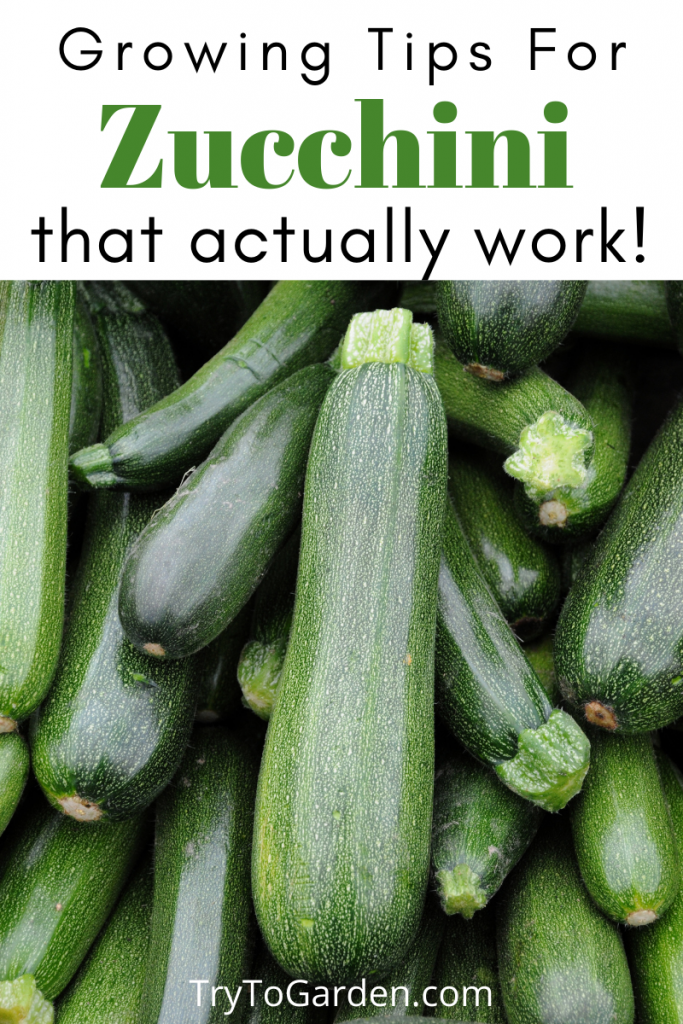This post contains affiliate links, which means I will make a commission at no extra cost to you should you click through and make a purchase. As an Amazon Associate I earn from qualifying purchases.
Gardening Tips for Zucchini? Zucchini is probably the best known of the summer squashes. It is a type of narrow squash that resembles a cucumber in size and shape. It has smooth, thin skin that is either yellow or green in color and can be striped or speckled. Its tender flesh is creamy white in color and features numerous seeds. Its edible flowers are often used in French and Italian cooking.

Dating back to 7000 B. C., zucchini (Cucurbita pepo) is native to Central and South America. Sometimes called by the nickname Italian Squash, zucchini was brought to North America by its southern neighbors. Early European explorers introduced zucchini to Italy and other countries in Europe.
Italians initially grew zucchini for their sweet, edible blossoms, later the hearty fruits were experimented with producing the delectable dishes that resulted in zucchini being dubbed Italian squash. Up until the 20th Century, most Americans considered zucchini a treat reserved for eating on special occasions and were store-bought instead of grown in gardens.
Benefits of Zucchini
Part of the summer squash family, zucchini is an excellent source of manganese and vitamin C, a very good source of magnesium, vitamin A, potassium, calcium, iron, folate, copper, riboflavin, niacin, and phosphorous. Many of the nutrients have been shown to be helpful for the prevention of atherosclerosis and diabetic heart disease.
Summer squash's magnesium has been shown to be helpful for reducing the risk of heart attack and stroke. Together with the potassium in summer squash, magnesium is also helpful for reducing high blood pressure. All summer squash are perfect diet foods - low in calories, sodium, fat-free, and provide a source of fiber. All parts of the zucchini are edible.
Basic Zucchini Facts
Seeds should sprout in 7-14 days.
Zucchini is a warm-season crop that cannot tolerate frost or freezing temperatures, so it's best to plant your zucchini in the early summer when temperatures are at least 70 degrees Fahrenheit or more.
Zucchini is a warm-season crop that cannot tolerate frost or freezing temperatures, so it's best to plant your zucchini in the early summer when temperatures are at least 70 degrees Fahrenheit or more.
They can produce up to ten pounds of zucchini squash per plant. They take about two months to harvest, can also be sowed and harvested multiple times per growing season.
While it's commonly served cooked, many people enjoy eating zucchini raw too, as it works great in salads, with dips, as a wrap, or even spiralized to make low-carb noodles
Soil
Zucchini doesn't require excessively nutrient-rich soil, but it does perform best in soils that are high in organic matter with a soil pH of around 6.5.
High organic matter usually means prepare the planting bed with lots of organic matter—a few inches of aged compost spread across the bed and then turned under. If leaves grow pale or plants seem weak, side-dress zucchini with well-aged compost or use a foliar spray of liquid fish or kelp fertilizer—high in phosphorus for fruit production.
Planting
Zucchini is a member of the Cucurbitaceae family that includes cucumbers, melons, gourds, and squash, all particularly sensitive to frost. Select a sheltered spot, and prepare holes about 12in/30cm in diameter and 12in/30cm deep. Measuring from the center, space the holes 36in/90cm apart for bush types, 6ft/1.8m apart for vines. To conserve space, squash can be trained over a sturdy trellis, in which case 2ft/60cm between plants is enough.

Zucchini can be planted by direct seeding or by transplanting young plants that have been started indoors. Seed directly into the ground as soon as the soil reaches temperatures of 60F/16C. for vines. Fill the holes with compost and mound slightly. Plant seeds 1in/2.5cm deep.
Zucchini Plant Care
Zucchini grows best when exposed to 6-8 hours of direct sunlight each day. Regular watering is essential for summer squash. Feed the plants with a high-potassium organic liquid feed to produce a higher yield. Thick mulch added after planting will preserve moisture and keep the fruits from touching the ground where they will become soiled and be exposed to insects and diseases.
In the garden, some gardeners let the squashes ramble through the corn patch, where their sandpapery leaves deter raccoons. Good companion plants for zucchini are corn, marjoram, and nasturtium. Don't grow zucchini and Irish potatoes together as they are incompatible.
Harvesting
The flavor of zucchini is best when it is less than six inches long. They should be firm, but not hard. Zucchini are prolific producers and regular harvesting will promote continued yield throughout the growing season. Harvest by cutting the stems from the plants gently with a paring knife.
As they are composed mainly of water, summer squashes dehydrate rapidly. Harvest just before cooking and keep in the refrigerator in a perforated plastic bag until cooking. Don't forget that squash blossoms are delicious to eat.

Zucchini Easy Recipe
Small summer squashes are used skin and all. Larger squash needs their skin and seeds removed: slice lengthwise and scoop out the seeds with a spoon. Wash summer squash under cool running water and then cut off both ends. You can then proceed to cut it into the desired size and shape for the particular recipe.
In the kitchen, zucchini can be steamed, sauteed, boiled, baked, fried, grilled, and stuffed. Some ideas include: serve raw as an appetizer with a vegetable dip or salad dressing, grate and sautee with thinly sliced garlic, add to bread, muffins, cakes, stews, casseroles, soups, sprinkle grated zucchini or other summer squash on salads or sandwiches. It can be preserved by canning, freezing, and drying.
We love this Cranberry Zucchini Bread Recipe from Operation $40K but this Zucchini Bread Recipe is good too - if you aren't a cranberry fan.
